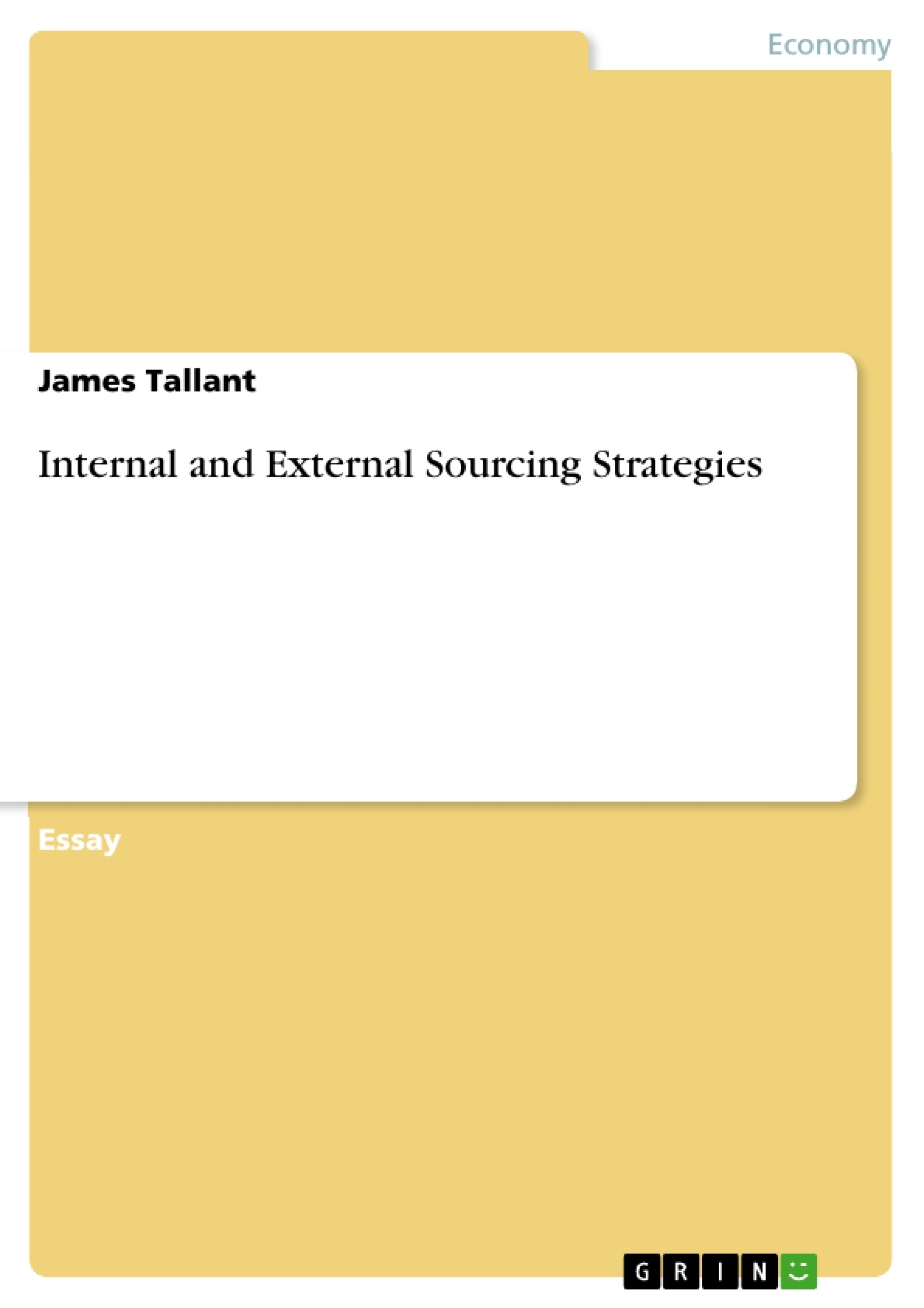Internal/External Sourcing Strategies Paper
Organizations face challenges to improve their financial standing. Challenges such as product design and quality, cost of goods sold, and cycle time contribute to an organizations financial health. To assist organizations better control these factors, supply chain management techniques, when implemented improve costs, delivery cycle times, and quality. Supply chain management achieves these goals through the use of strategic sourcing. Strategic sourcing leads organizations’ to decide whether they want to keep certain activities in-house or internally or if they want to outsource or have certain activities done externally for them by another organization or supplier. This paper will evaluate the differences between internal and external sourcing strategies in service and manufacturing organizations. In addition, advantages and disadvantages of outsourcing to foreign countries are reviewed. Finally, a favorable position of outsourcing to a foreign country is undertaken with supporting evidence.
Internal/External Sourcing Strategies Paper
Organizations face challenges to improve their financial standing. Challenges such as product design and quality, cost of goods sold, and cycle time contribute to an organizations financial health. To assist organizations better control these factors, supply chain management techniques, when implemented improve costs, delivery cycle times, and quality. Supply chain management achieves these goals through the use of strategic sourcing. Strategic sourcing leads organizations’ to decide whether they want to keep certain activities in-house or internally or if they want to outsource or have certain activities done externally for them by another organization or supplier. This paper will evaluate the differences between internal and external sourcing strategies in service and manufacturing organizations. In addition, advantages and disadvantages of outsourcing to foreign countries are reviewed. Finally, a favorable position of outsourcing to a foreign country is undertaken with supporting evidence.
Service Organizations Internal Sourcing
Based in part on the make or buy concept, many service organizations opt to keep some business functions internally. Internal souring often results in an organization retaining what it dose best as part of its core competencies. Therefore, it can focus on what it does best and taking care of its customers. Moreover, the function of selecting and controlling an outsourcing service organization is expensive. Organizations often retain innovative services internally such as service consulting, financial auditing, or research and development. In doing so, organizations maintain a closer look and focus on their core competencies that correspond with the organizations mission, vision, and value statements and ultimately how well they are satisfying their customers while minimizing value leakage of the organization.
Manufacturing Organizations Internal Sourcing
Manufacturing organizations face the same set of questions as service organizations on when and how to keep business functions within the organization or out of the organization. Manufacturing organizations differ from service organizations because of the products they provide instead of just a service as the service organizations provide. However, manufacturing organizations wish to identify and retain their core competencies. By refining and executing core competencies through the use of value engineering and make versus buy analysis for a particular part, organizations can quickly distinguish what functions can be internally or externally sourced. Often many manufacturing organizations keep final production or assembly in-house along with research and development. Because these functions drive a manufacturer toward one’s ultimate goal of customer satisfaction by way of one’s mission, vision, and value statements, these core competencies are left internally. Moving these vital core competencies externally risks the loss of control of the process.
Service Organizations External Sourcing
According to Ellram, Tate, and Billington (2004), “There has been significant increase in the outsourcing of organizations’ internal functions to specialists firms, converting those company functions into procured services” p. 19, para. 7). Various former internal sourcing activities from support areas such as customer service, technical service, and product design are moving oversees allowing organizations to focus on one’s core business competencies. Using spending analysis and e-sourcing tools, service organizations can rationalize and justify the number and types of external sources to use. Among the service organizations using external sourcing include IT functions, preliminary research or analysis such as in medical or legal transcribing, preliminary accounting or auditing translation, limited research and development, and accounting or back room operations.
Manufacturing Organizations External Sourcing
Manufacturing organizations undertake the external sourcing in a similar fashion that a service organization does. However, because manufacturers produce a product additional research and recommendations are required. Often an organization will find through the use of various tools such as the team approach to global sourcing that various functions the organization performs can be sourced externally for less and without harming the organizations core competencies and customer satisfaction. By following 10 steps: 1) Identify a need for strategic sourcing, 2) develop clear goals and objectives, 3) create a cross-functional team, 4) conduct supplier research, 5) prepare request for quotes (RFQ), 6) send RFQ to selected suppliers, 7) analyze the responses, 8) conduct site visits, 9) conduct negotiations, and 10) award the business. Following these 10 guidelines provides an organization the tools to make a wise decision on whom to externally or outsource to and what to outsource as far as sub-components or parts involved in manufacturing are concerned.
[...]
- Citar trabajo
- James Tallant (Autor), 2010, Internal and External Sourcing Strategies, Múnich, GRIN Verlag, https://www.grin.com/document/167300
-

-

-

-
¡Carge sus propios textos! Gane dinero y un iPhone X. -

-
¡Carge sus propios textos! Gane dinero y un iPhone X. -

-
¡Carge sus propios textos! Gane dinero y un iPhone X. -

-
¡Carge sus propios textos! Gane dinero y un iPhone X. -

-
¡Carge sus propios textos! Gane dinero y un iPhone X.

